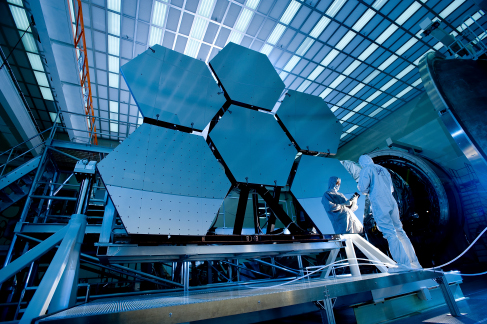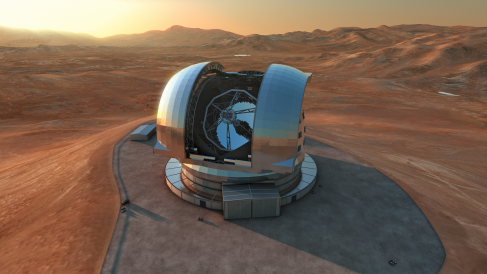Chapter 6 Astronomical Instruments
6.6 The Future of Large Telescopes
Learning Objectives
By the end of this section, you will be able to:
- Describe the next generation of ground- and space-based observatories
- Explain some of the challenges involved in building these observatories
If you’ve ever gone on a hike, you have probably been eager to see what lies just around the next bend in the path. Researchers are no different, and astronomers and engineers are working on the technologies that will allow us to explore even more distant parts of the universe and to see them more clearly.
The premier space facility planned for the next decade is the James Webb Space Telescope ([link]), which (in a departure from tradition) is named after one of the early administrators of NASA instead of a scientist. This telescope will have a mirror 6 meters in diameter, made up, like the Keck telescopes, of 36 small hexagons. These will have to unfold into place once the telescope reaches its stable orbit point, some 1.5 million kilometers from Earth (where no astronauts can currently travel if it needs repair.) The telescope is scheduled for launch in 2018 and should have the sensitivity needed to detect the very first generation of stars, formed when the universe was only a few hundred million years old. With the ability to measure both visible and infrared wavelengths, it will serve as the successor to both HST and the Spitzer Space Telescope.

On the ground, astronomers have started building the Large Synoptic Survey Telescope (LSST), an 8.4-meter telescope with a significantly larger field of view than any existing telescopes. It will rapidly scan the sky to find transients, phenomena that change quickly, such as exploding stars and chunks of rock that orbit near Earth. The LSST is expected to see first light in 2021.
The international gamma-ray community is planning the Cherenkov Telescope Array (CTA), two arrays of telescopes, one in each hemisphere, which will indirectly measure gamma rays from the ground. The CTA will measure gamma-ray energies a thousand times as great as the Fermi telescope can detect.
Several groups of astronomers around the globe interested in studying visible light and infrared are exploring the feasibility of building ground-based telescopes with mirrors larger than 30 meters across. Stop and think what this means: 30 meters is one-third the length of a football field. It is technically impossible to build and transport a single astronomical mirror that is 30 meters or larger in diameter. The primary mirror of these giant telescopes will consist of smaller mirrors, all aligned so that they act as a very large mirror in combination. These include the Thirty-Meter Telescope for which construction has begun at the top of Mauna Kea in Hawaii.
The most ambitious of these projects is the European Extremely Large Telescope (E-ELT) ([link]). (Astronomers try to outdo each other not only with the size of these telescopes, but also their names!) The design of the E-ELT calls for a 39.3-meter primary mirror, which will follow the Keck design and be made up of 798 hexagonal mirrors, each 1.4 meters in diameter and all held precisely in position so that they form a continuous surface.
Construction on the site in the Atacama Desert in Northern Chile started in 2014. The E-ELT, along with the Thirty Meter Telescope and the Giant Magellan Telescope, which are being built by international consortia led by US astronomers, will combine light-gathering power with high-resolution imaging. These powerful new instruments will enable astronomers to tackle many important astronomical problems. For example, they should be able to tell us when, where, and how often planets form around other stars. They should even be able to provide us images and spectra of such planets and thus, perhaps, give us the first real evidence (from the chemistry of these planets’ atmospheres) that life exists elsewhere.

New and even larger telescopes are on the drawing boards. The James Webb Space Telescope, a 6-meter successor to Hubble, is currently scheduled for launch in 2018. Gamma-ray astronomers are planning to build the CTA to measure very energetic gamma rays. Astronomers are building the LSST to observe with an unprecedented field of view and a new generation of visible-light/infrared telescopes with apertures of 24.5 to 39 meters in diameter.
For Further Exploration
Articles
Blades, J. C. “Fixing the Hubble One Last Time.” Sky & Telescope (October 2008): 26. On the last Shuttle service mission and what the Hubble was then capable of doing.
Brown, A. “How Gaia will Map a Billion Stars.” Astronomy (December 2014): 32. Nice review of the mission to do photometry and spectroscopy of all stars above a certain brightness.
Irion, R. “Prime Time.” Astronomy (February 2001): 46. On how time is allotted on the major research telescopes.
Jedicke, Peter & Robert. “The Coming Giant Sky Patrols.” Sky & Telescope (September 2008): 30. About giant telescopes to survey the sky continuously.
Lazio, Joseph, et al. “Tuning in to the Universe: 21st Century Radio Astronomy.” Sky & Telescope (July 2008): 21. About ALMA and the Square Kilometer Array.
Lowe, Jonathan. “Mirror, Mirror.” Sky & Telescope (December 2007): 22. On the Large Binocular Telescope in Arizona.
Lowe, Jonathan. “Next Light: Tomorrow’s Monster Telescopes.” Sky & Telescope (April 2008): 20. About plans for extremely large telescopes on the ground.
Mason, Todd & Robin. “Palomar’s Big Eye.” Sky & Telescope (December 2008): 36. On the Hale 200-inch telescope.
Subinsky, Raymond. “Who Really Invented the Telescope.” Astronomy (August 2008): 84. Brief historical introduction, focusing on Hans Lippershey.
Websites
Websites for major telescopes are given in [link], [link], [link], and [link].
Videos
Astronomy from the Stratosphere: SOFIA: https://www.youtube.com/watch?v=NV98BcBBA9c. A talk by Dr. Dana Backman (1:15:32)
Galaxies Viewed in Full Spectrum of Light: https://www.youtube.com/watch?v=368K0iQv8nE. Scientists with the Spitzer Observatory show how a galaxy looks different at different wavelengths (6:22)
Lifting the Cosmic Veil: Highlights from a Decade of the Spitzer Space Telescope: https://www.youtube.com/watch?v=nkrNQcwkY78. A talk by Dr. Michael Bicay (1:42:44)

